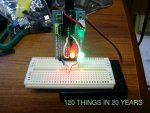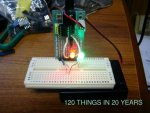We haven't even finished up with resistance, Pete.

The one difference in the water tap analogy that is important for resistors is that as current flows through them, voltage is dropped by them. As the "volume" of current flows through them, the "pressure" (voltage) drops. The difference between the input voltage and the output voltage means that there is a specific voltage difference between the input and the output that has been "dropped" by the resistor. Where did it go? It went into heat.
A resistor dissipates heat as it drops voltage, sometimes a little, sometimes a lot. The amount dissipated can be known by applying this formula: P=IR. That's Power (P) dissipated by the resistor equals current (I) times Resistance (R).
And no, I don't know why the letter "I" is used to represent current. Just a tradition, I guess. Perhaps someone else here knows. But by applying this formula you can calculate just how much heat will be dissipated (in Watts) by a given resistor at a given voltage or current.
That's important, because an incorrectly sized resistor can get too hot and start a fire, or pop like a fuse but in a much messier manner.
The other equation necessary for working with resistors is E=IR. That's E (for electromotive force {we call it voltage}) equals I (current) times R (resistance.) With this equation and knowing the values of any 2 of the variables you can calculate the third value. You will find many online calculators that will calculate these voltages, currents, resistances and power for you if you simply plug in the values you have. Just do a web search for "Ohm's Law calculator," or if you're handy with math just grab a pocket calculator and do it yourself.
Sorry if this sounds too inane. It's very difficult to know in the forum just what a poster already understands and what they don't, so I usually try to keep everything as simple as I can. It doesn't hurt those with a deeper knowledge, and it helps those who are looking at something totally foreign to them.




